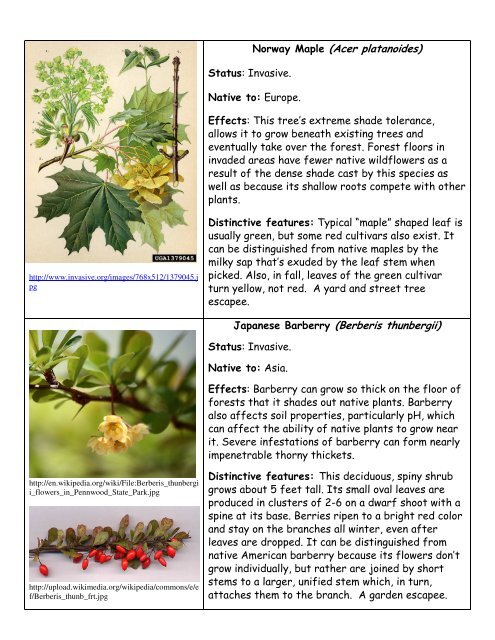Invasive Plants Flashcards (pdf)
Invasive Plants Flashcards (pdf)
Invasive Plants Flashcards (pdf)
You also want an ePaper? Increase the reach of your titles
YUMPU automatically turns print PDFs into web optimized ePapers that Google loves.
http://www.invasive.org/images/768x512/1379045.j<br />
pg<br />
http://en.wikipedia.org/wiki/File:Berberis_thunbergi<br />
i_flowers_in_Pennwood_State_Park.jpg<br />
http://upload.wikimedia.org/wikipedia/commons/e/e<br />
f/Berberis_thunb_frt.jpg<br />
Status: <strong>Invasive</strong>.<br />
Norway Maple (Acer platanoides)<br />
Native to: Europe.<br />
Effects: This tree’s extreme shade tolerance,<br />
allows it to grow beneath existing trees and<br />
eventually take over the forest. Forest floors in<br />
invaded areas have fewer native wildflowers as a<br />
result of the dense shade cast by this species as<br />
well as because its shallow roots compete with other<br />
plants.<br />
Distinctive features: Typical “maple” shaped leaf is<br />
usually green, but some red cultivars also exist. It<br />
can be distinguished from native maples by the<br />
milky sap that’s exuded by the leaf stem when<br />
picked. Also, in fall, leaves of the green cultivar<br />
turn yellow, not red. A yard and street tree<br />
escapee.<br />
Japanese Barberry (Berberis thunbergii)<br />
Status: <strong>Invasive</strong>.<br />
Native to: Asia.<br />
Effects: Barberry can grow so thick on the floor of<br />
forests that it shades out native plants. Barberry<br />
also affects soil properties, particularly pH, which<br />
can affect the ability of native plants to grow near<br />
it. Severe infestations of barberry can form nearly<br />
impenetrable thorny thickets.<br />
Distinctive features: This deciduous, spiny shrub<br />
grows about 5 feet tall. Its small oval leaves are<br />
produced in clusters of 2-6 on a dwarf shoot with a<br />
spine at its base. Berries ripen to a bright red color<br />
and stay on the branches all winter, even after<br />
leaves are dropped. It can be distinguished from<br />
native American barberry because its flowers don’t<br />
grow individually, but rather are joined by short<br />
stems to a larger, unified stem which, in turn,<br />
attaches them to the branch. A garden escapee.


